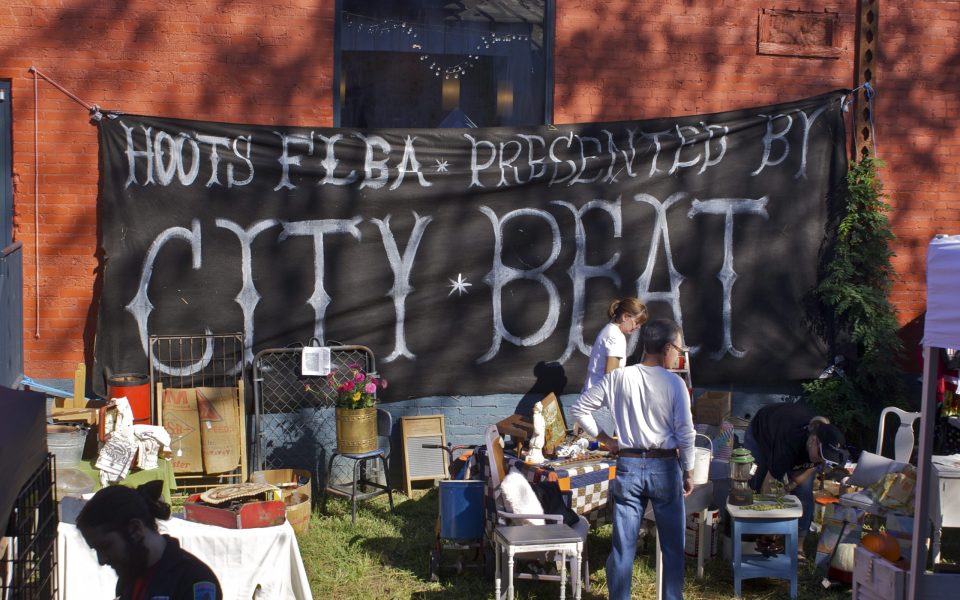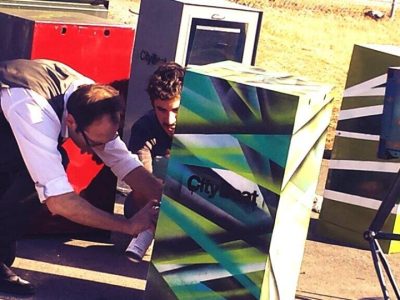On Friday night in Winston-Salem’s West End, developer John Bryan bellies up to the bar at Hoots and gets himself a Wild Turkey on the rocks. Why not? It’s been a long day at the West End Mill Works, his current project, and there’s more like it to come.
He’s in the same clothes he’s been wearing all day: work jeans and flannel. Combined with his autumn beard and trucker cap, it gives him the outward appearance of a carpenter, which is in fact how he once made his living.
He’s still handy with a hammer and nails — he spent the day erecting the monthly village that is Hoots Flea Market with his partner in the venture, Joe Bradford, and they’ll be out there first thing in the morning to hang banners and put the finishing touches on the pumpkin patch, the balloon dartboard, the stage and the sound system.
The flea market is just the latest bough on Bryan’s entrepreneurial tree that goes back more than a decade, laying roots throughout Winston-Salem’s most cultured corners.
Hoots Flea Market was conceived, planned and given the green light during a single 20-minute conversation in the parking lot of Krankies Coffee, another pearl in Bryan’s string of influence. It was up and running within a month.
Krankies took a bit longer to flesh out.
The space at the corner of East Third Street and Patterson Avenue known as Krankies began its life as a meatpacking facility and then, along with a lot of the rest of that industrial neighborhood, went fallow.
In the mid-1990s, a group of young men got their hands on the building — the technical term for what they did may be “squatting” — dubbed it the “Werehouse” and began using the space for art and music.
This was a very different time for downtown Winston-Salem, before the Arts District had evolved and the restaurant row on West Fourth Street came of age. There was no Foothill’s Brewing, no Finnegan’s Wake or Silver Moon Saloon. Ziggy’s was still over on Baity Street, and the Garage was just a gleam in Richard Emmett’s eye. Allen Joines was still city manager; he wouldn’t become mayor until 2001.
The area around the Werehouse was industrial gothic, uninhabited, sketchy. It was possible in those days for these rock shows and art openings to escape official notice.
It was a half-assed political stunt that put them on the official radar, and that’s what John Bryan wants to talk about tonight.
When the W. Dennie Spry Soccer Stadium opened on the Wake Forest University Campus in 1996, Bryan and the crew from the Werehouse dressed as monsters and mounted a protest, the intent of which is unclear.
By 1997 the bohemian crew had bought the building — it sold for $60,000, with a tax value today of $312,500 — which began attracting a series of visits from the police department and fire marshall after the monster mash. It could have been the end for this vanguard of the cultural movement in the City of Arts and Innovation. Winston-Salem would be a very different place today had the Werehouse been shut down.
For advice, Bryan called on city council member Wanda Merschel — he knew her because he made her cabinets. He says she was able to help get the fire department off his back.
And he found another powerful ally in one of the city’s favorite sons.
Phil Hanes was a philanthropist and patron of the arts who spent the last three decades of his life crafting Winston-Salem’s reputation as the City of the Arts.
Hanes helped start the Southeastern Center for Contemporary Art and the Piedmont Opera in the 1950s, when he was still president of the Hanes Finishing & Dye Co., the family business. In 1997 he gave $1 million to the UNC School of the Arts, which he had helped found 50 years ago, and another million in 2000. He was the man behind the Stevens Center and joined the city’s Arts Council, the first in the country, a year after it was created. His reputation extended beyond the borders of the city to state and national arts groups. When Hanes died in 2011, his ashes were left inside a piece of public art created specifically for that purpose.
But he was alive and well back then at the turn of the century, and Bryan thought Hanes might understand the movement he was trying to foment.
“Someone said I should meet him,” Bryan says, leaning over the bar. “I just went to his office and knocked on his door.”
At his audience with Hanes, Bryan explained what he and his mates were trying to do with their space — live music and art, culture emanating from a forgotten district, the development of human capital. He couldn’t get a read on the guy.
“He didn’t say much,” Bryan remembers, “but he got to work.”
Hanes took a shine to the Werehouse crew and made some calls on their behalf. The Werehouse eventually morphed into PS 211, a nonprofit with backing from the Arts Council and SECCA. That, Bryan says, was Hanes’ doing.
“[Hanes] would go to boardrooms and official meetings and say, ‘These kids are the future of the city. You need to pay attention to them and you need to help them,’” Brian says. “He got it.”
And with that he finishes his bourbon, pays his tab and heads out the door. Gonna be an early day tomorrow.
PS 211 really became Krankies when they purchased the roasting operation of Maria Braught, one of the city’s first foodies of the modern era, on a handshake deal in her kitchen.
They needed something to sell with the coffee, so Cary Clifford set up shop in the basement in an effort that would eventually become Camino Bakery, today a Fourth Street landmark.
A farmers market began holding court in the parking lot on Tuesdays, and the Cobblestone Farmers Market was born.
Now the retail spots along Patterson are full. Reanimator, a record and curio shop, came on last year. There’s also a store that sells clothes for dogs.
In 2009, Bryan and his partners in Krankies moved into the Arts District with Single Brothers, a barroom smaller than a garage where Eric Swaim cut his teeth as a bartender before opening Hoots Roller Bar almost exactly a year ago and beginning brewing operations in the West End Mill Works.
Besides Hoots, the Mill Works houses the Breathing Room, a holistic healing space; Sutler’s Spirit Co., which will be putting out its first bottles of gin this winter; Eight Points Muay Thai & Fitness boxing gym; the Porch Restaurant & Cantina; and the Olio, an open glass-blowing studio.
Bryan says he “curates his tenants,” looking to create entrepreneurial cultures that, like Krankies, galvanize existing community networks into successful businesses.
“It’s development from the standpoint that the community is developing it,” Bryan says. “We’ve got layers of support, and not all of it is financial.”
It’s Friday morning, hours before he has his nightcap at Hoots, and he’s taking a break in the shade by the creek that flows through the property at the West End Mill Works, one of the few moving waterways in the city, he points out.
The property is significant because it links three disparate neighborhoods — the affluent Buena Vista, funky West End and Thurmond, a working-class African-American neighborhood.
“The stuff that ‘gets on the radar,’ gets attention from banks, that’s the stuff everybody has,” Bryan says. “That’s your Walgreen’s, your McDonald’s. Every city has those.”
Bryan’s tenants share a few common traits: They’re all local and one of a kind; they’re all run and staffed by people deeply committed to the enterprises; and they all gain immediate acceptance by Winston-Salem’s culturati — the people who actually go out and do stuff.
And it’s not gone unnoticed.
Last month the city of Winston-Salem agreed to a $200,000 gap loan for Bryan’s development company towards redevelopment of the complex, into which he’s already poured $1.4 million. And he confirms that his name is being bandied about across the Sandy Ridge Curtain, in downtown Greensboro, for custodianship of the derelict Cascade Saloon, recently acquired by that city under eminent domain, though he’s unwilling to discuss the project.
Bryan’s track record of success and cultural penetration has cast him in the role of developer, a title he shrugs off.
“I don’t know,” he says. “I’m not sure you can really give a title to what I do. I don’t have all the trappings — what people think I should look like. But they’re looking at what we do.”
For tomorrow’s flea there will be a pumpkin patch and a pie-eating contest amid the vintage goods and artisanal offerings. Space at the market is free and open to all in the grassy alley between the cinderblock Mill Works proper and the mill itself.
“We don’t do tube socks, we do cool stuff,” Joe Bradford says. “We don’t do tube socks and we don’t do puppies.”
Bradford’s a West Coast pitchman with big ideas and just a little bit of carny to him. Before he met Bryan in the parking lot of Krankies and convinced him to back the Hoots Flea Market, Bradford was buying old Ford trucks in rural North Carolina towns and flipping them in Lower Manhattan, where the vehicles are looked upon as exotic and rare.
“In the West Village,” he says with a twinkle, “10 grand is what some of these folks spend on a bottle of wine.”
The flea-market idea was a variation on that theme. He’d seen them before — in New York, in San Francisco, in Raleigh, for god’s sake — and knew something like it would work in Winston-Salem.
“[In the South] there’s this cultural connection [to flea markets],” he says. “It’s so different from the West Coast.”
He’s got big plans: outdoor movies, holiday nights and roving performers to complement the food trucks, farmers and vendors. He’s already staged a pop-up bike shop and barbershop at the flea, and he gives the impression that he’s got a few dozen more tricks up his sleeve.
“It’s not just a flea,” he says. “We want action and events, artists, music, pie-eating…. We want it to be like the old carnival days.”
He’ll have a hand in the restoration of the mill itself, a building of corrugated steel and good wood, and the grounds around it, which he envisions will grow well past the flea market. He wants to make a small beach on the stream, turn the building into an event space, maybe a gallery. Something interesting and vibrant. He’s not exactly sure what. He and Bryan will work that out later.
“The space is not available for someone who just wants to store boxes,” Bryan says. “There’s money in it, but there’s no payoff. That’s not it. We’re looking for things with exponential potential.”
Across the grass alley, the Mill Works teems with life. There’s a line out the door at the Porch, where the smell of cooking beef wafts down the halls and patio patrons eat Tex-Mex fare at tables and chairs repurposed from old shipping pallets. Rebeccah Byer Rush slides a gummy wad of molten glass into the fiery gloryhole at the Olio, slowly turning it into a light fixture as an onlooker watches from a wooden table.
In his distillery, Scot Sanborn treats a small wooden cask with warm water so it can properly age alcohol. He came to Bryan after looking for a downtown space for his distillery, the first in the city in decades.
“I had nothing, just the dream,” says Sanborn, who lives in Summerfield. “I was looking for a city with a supportive culture. [Bryan] had a reputation as a facilitator, a guy who makes things happen. He sold me on the idea of the West End Mill Works.
“He puts culture before profit,” Sanborn adds. “He knows that the profits will come if you cultivate it.”
At the Breathing Room, Suzy McCalley preaches the connection between art and wellness in this space designed for yoga and massage as well as performance and exhibition. She and partner Emily Stewart have been open about a year.
“I knew John had vision,” McCalley says. “I trusted him. I get his aesthetic; I get his philosophy. I really vibe with that. I knew [the Mill Works] was gonna be the next big thing and I wanted to be a part of it.
“Plus,” she says, “it was really affordable.”
On Saturday morning in the Eight Points Muay Thai & Fitness gym, owner Chris Clodfelter presides over a score of hopeful, sweaty contenders on the mats, demonstrating explosive right-leg kicks to the class. In the ring, World Kickboxing Association Glory Rules Champion Aracely Valenzuela trains hard with mixed martial-arts fighter Kyle Martin.
“It’s not all about fighting,” Clodfelter says. “I teach the history and culture of Thailand, the spiritual basis of it all. John understands that. He’s not gonna let some guy come in here to teach people how to knock people out.”
By now the pumpkins have gathered in a promenade in the shade cast by the old mill and the vendors are claiming spaces to display their wares: old bottles, wooden state cutouts, old clock radios and typewriters, vintage clothing and jewelry, license plates, yellowed dress patterns in their original envelopes, needlepoint, clown statuary, old Life magazines, T-shirts, tchotchkes and a skeleton dressed like a hula girl.
Bradford’s running around like a hipster interlocutor in a vest and knotted necktie before the influx begins.
John Bryan — flannel, jeans — surveys the pumpkin patch and adjusts the black banners to his satisfaction. He pauses, but not without argument, to pose for a picture with Bradford and then the two separate. Bradford’s got a market to run. Bryan has to focus on another project for a few hours.
“It’s not like it’s one grand marshal who’s driving the whole thing,” Bryan says. “People pick it up and move it on down the road. Look at the Roller Bar. These guys were bartenders and musicians. They opened a brewery, and they’re killing it.”
He remembers a trip to New York City back around the turn of the century, seeing a tourism ad for Winston-Salem flashing on the bright lights of Times Square.
“That’s the opposite of what Winston-Salem is,” he says. “We are a world-class city, and we’re all down here doing all this work and they’re spending 50 grand on a marketing campaign.
“We’re out to make money,” he continues. “I have no problem with money. It’s one of the tools in the toolbox. But you gotta know how to use it.”
He casts a glance at the creek running through the mill and applies to it his singular vision.
“This creek is a waterway that’s been dumped in for years,” he says. “But now there’s great blue heron here. There’s literally trout in this fucking stream.”
It’s alive once more, like this forgotten, industrial corridor itself, and it connects every corner of the city. The plan is to “catalyze value” from the moving water — clean it up, give it the proper appreciation, see where it goes.
“Community development is a cornerstone of how we develop,” he says.
He’s talking about real estate, to be sure, but he’s also talking about the development of human equity, cultural capital and the compounding power of place.
He’s a developer, alright, but maybe not like one might think. And the former attic dweller of the Werehouse still bristles at the label.
“We are developers, and we’re being taken seriously,” he says. “But the fact that we’re doing stuff and are in that category is a fucking miracle.”
Join the First Amendment Society, a membership that goes directly to funding TCB‘s newsroom.
We believe that reporting can save the world.
The TCB First Amendment Society recognizes the vital role of a free, unfettered press with a bundling of local experiences designed to build community, and unique engagements with our newsroom that will help you understand, and shape, local journalism’s critical role in uplifting the people in our cities.
All revenue goes directly into the newsroom as reporters’ salaries and freelance commissions.

 Hoots Flea ties into the Southern flea-market tradition, with a modern cultural twist.
Hoots Flea ties into the Southern flea-market tradition, with a modern cultural twist.
 MMA fighter Kyle Martin trains with kickboxer Aracely Valenzuela at Eight Points Muay Thai at the West End Mill Works.
MMA fighter Kyle Martin trains with kickboxer Aracely Valenzuela at Eight Points Muay Thai at the West End Mill Works.




I loved this article. Nice to see JB getting some much deserved love.
amen! forced gratitude that he cant just shrug off 😉 way to live JB
pete mikkola
GREAT article about West End Mill Works, Hoots Flea and John Bryan and Joseph Bradford, two extraordinary “movers and shakers”….as well as two exceedingly nice people. .
How does one become a vendor at this market?